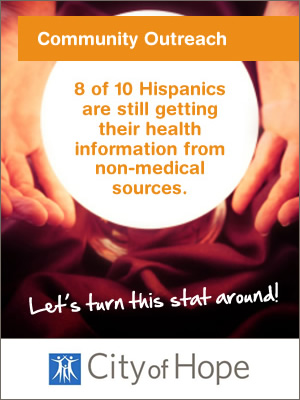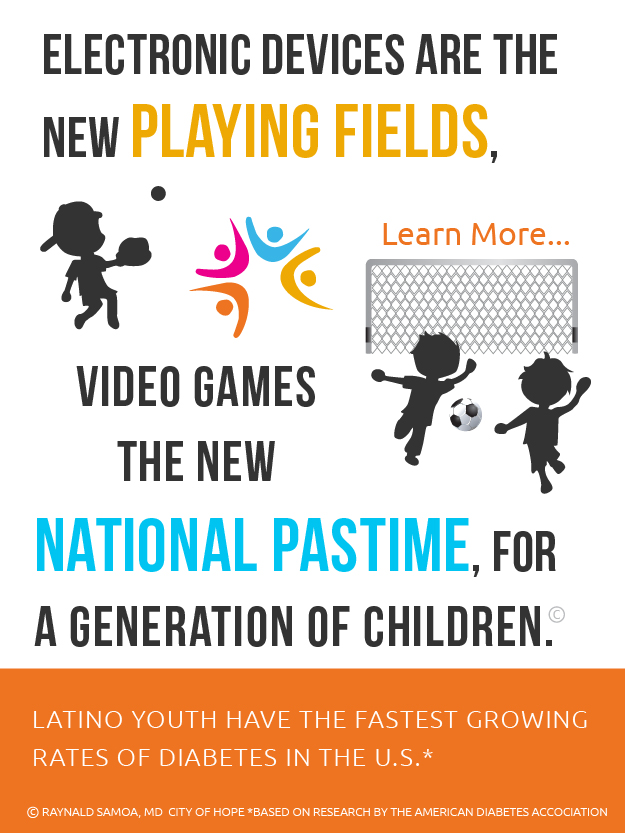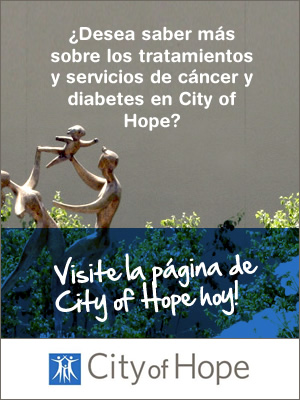
Healing Tension Points Will Unlock the Hispanic Healthcare Opportunity
09/25/2015 06:00AM | 10573 viewsAccording to a Cancer Journal for Clinicians report cited by City of Hope in 2012, the leading cause of death in the U.S. Hispanic community is cancer – even though heart disease has held that distinction among all Americans since 1921. Earlier that same year, the American Diabetes Association revealed that young Latinos have the highest growth rate of diabetes of any group in the country.
As the leading research and treatment center for cancer, diabetes and other life-threatening diseases, City of Hope took notice. While genetics, diet and other lifestyle choices might be part of the explanation, so could access to healthcare, availability of research, and knowledge about treatment and prevention.
A disconnect between the largest minority in the U.S. – one whose growth continues to outpace any other group – and the healthcare services available to them in this country should be of great concern to all. In fact, according to an article in Bloomberg Businessweek, President Barack Obama’s Affordable Care Act depends on Hispanic numbers. The new “health exchanges” will depend on 40%, or 2.6 million, young and healthy people buying insurance to balance out those older and infirm. Hispanics offer a pool of participants in the neighborhood of 10.2 million people, and the administration is working closely with Spanish-language media to reach them.
The growth of the Hispanic community really took off in the first decade of the new century. Between 2000 and 2010, the Hispanic population grew by 43 percent, or four times the nation's 9.7 percent growth rate. In real numbers, this was an increase of 15.2 million people of Hispanic descent and accounted for more than half of the total U.S. population increase. Today, Hispanics are 50.5 million people strong – but given what we are learning, are they healthy?
For example, as pointed out on the Hispanic Health Information Portal, Hispanics are getting caught up in our country’s obesity epidemic – fueled by assimilation and their growing addiction to the American diet and other lifestyle choices – and that is contributing to the high percentage of diabetes in the community. Mexican Americans, in particular, “are almost twice as likely as non-Hispanic whites to be diagnosed with diabetes by a physician … and they are 50% more likely to die from diabetes as non-Hispanic whites,” according to the U.S. Department of Health and Human Services Office of Minority Health.
As most of us know, pursuing the American Dream often comes with a heavy price: desk jobs that provide little time for exercise and a steady diet of fast food – leading to weight gain, stress and other negative effects on physical health and well-being. We are seeing the harm being done in the Hispanic community, in the form of increased rates of diabetes (especially in Hispanic youth) and other diseases. Healthcare professionals serving the Hispanic community can begin to reverse this trend by promoting nutrition, physical activity, and other healthy habits that can benefit the community, not least the next generation of Hispanics. In the meantime, they must become more culturally aware when administering treatment.
Dr. Joseph Alvarnas, Director of Medical Quality and Associate Professor in the Department of Hematologic Oncology and Hematopoietic Cell Transplantation at City of Hope, worries that generic healthcare intervention puts the whole system at risk.
“Unless we change how we think, then we can’t achieve the ultimate purpose of people getting better. We are finding the ethnic and cultural diversity of humanity requires tailoring our approach to the healthcare needs of the individual – what we call personalized medicine.
“Cultural perceptions, fears and concerns must be respected and taken into account when determining the best treatment for patients. For example, we have learned that pills are more effective when treating Hispanic diabetics, even though insulin may be the most appropriate treatment overall. But insulin crosses a cultural bridge: it represents an admission by the Hispanic patient that they have a disease or weakness.”
Unresolved “tension points,” or healthcare gaps, with the Hispanic community will only grow wider if we don’t make an effort to understand their health issues and begin the work to overcome them. Because professional healthcare is not necessarily something Hispanics were raised with in their mother countries or even in their homes here in the U.S., they may not seek it out or see the value in it, making outreach to the community all the more important – especially as lack of medical research, prevention methods and treatment options specific to them directly affects their health and well-being.
Educating Hispanic students about the benefits of pursuing a career in healthcare and conducting recruitment outreach toward them is one way to tackle the issue from within the community. After all, only 5 percent of physicians in the U.S. are Hispanic, a cultural group that represents more than 3 times that in the general population. As City of Hope pointed out in a recent press release, recruiting more Hispanics into the healthcare industry will result in more Hispanic doctors and other healthcare professionals, who can more readily address the tension points with the community and also help non-Hispanics within the industry reach out to and treat their Hispanic patients more effectively.
So what are these tension points with the Hispanic community that the industry must heal? Here are a few causes and effects along with some actions that can be taken to begin to relieve the tensions.
Lack of Targeted Healthcare Information for Hispanics
According to a Pew Hispanic Center Report, Hispanics receive little if any information specifically targeting their healthcare needs and concerns. This lack of information translates into a false perception within the community that they don’t need healthcare. In fact, according to the report, most Hispanics without a primary care provider say they don’t have one because they don’t perceive themselves as someone who has to worry about getting seriously ill. While it is true that there seems to be a lower occurrence of some chronic health problems in the Hispanic community, there are notable exceptions and diabetes is at the top of that list. Not surprising, when you consider that Hispanics score low on the diabetes knowledge index – even those with health insurance and/or a regular healthcare provider.
This is what happens when a group, especially one as large as Hispanics, is not being served with appropriate content targeted for them. In order for the importance of such healthcare initiatives as preventative medicine, regular check-ups and timely treatment to resonate, the information from healthcare providers must specifically connect with the individual and their cultural identity.
Not Enough Outreach from the Medical to the Hispanic Community
The same Pew Hispanic Center Report found that at least 8 out of 10 Hispanics get information about their health from sources other than medical professionals, and more than half of the time this communication is in Spanish (or a mix of Spanish and English). These are non-medical sources such as television and radio programs and advertisements, yet almost 80% of Hispanics will take further action when they hear these messages.
This is obviously a community open to and eager for more information about their health, and a further sign that the medical community needs to be more proactive in reaching out to this group. There’s no excuse to let healthcare information continue to be randomly distributed by those outside the industry, especially in an age where the growing prevalence of social media and mobile devices offers unprecedented opportunities and tools for reaching out to specific consumers, in this case the Spanish-speaking and bilingual Hispanic community.
“Hispanics will trust non-medical resources that are culturally relevant and that speak their language; even more, those that create a two-way conversation and engage the community to be part of the solution,” says Dr. Kimlin Tam Ashing-Giwa, professor and director of City of Hope’s Center of Community Alliance for Research and Education.
“Healthcare system clinicians and researchers that take a one-sided approach create barriers to community entry and make it difficult for Hispanics to believe that they have their best interests at heart. At City of Hope, we see the difference between outreach – telling others – and engagement – speaking with others – and we believe community engagement is the best means to earning loyalty and trust with Hispanics.”
Hispanics Have a Higher Risk of Preventable Disease, Injury and Death
According to the National Alliance for Hispanic Health, the risk of preventable disease, injury and death is higher in the Hispanic community compared to the general population.
This fact alone places a great urgency on the need to discuss healthcare and prevention issues with the Hispanic community. First must come greater cultural intelligence and awareness within the healthcare industry in order to effectively and authentically administer to Hispanics.
Stephanie Neuvirth, Chief Human Resources and Diversity Officer at City of Hope, says that, “As healthcare leaders, we must be more culturally intelligent to understand the needs of our patients as well as our Hispanic employees – whose numbers are growing as we expose more Latino students to science and health at a young age, encourage their interest in clinical and research professions and recruit more Hispanics into the industry. As we start to mirror the community that we serve, this will help us become more culturally intelligent and enable us to unlock more clinical, research and educational opportunities.”
What the community needs specifically, according to the Alliance, are culturally tailored and language appropriate healthcare programs and services, which can then be promoted in the National Hispanic Family Health Helpline, a database of healthcare providers available to the community. But prevention hinges on getting healthcare information to the Hispanic community in a more timely manner as well. The Alliance suggests some quick-fix actions that the industry can work on immediately, such as: adapting current printed materials for the Hispanic community; developing a Spanish language web site and social media presence with health topics geared for Hispanics; adapting and distributing critical consumer health updates more quickly to the Hispanic community, such as food and drug recalls and other warnings; and developing a media plan that includes wire services serving Spanish language media and local community newspapers.
Jose De La Rosa, Senior Director, Corporate Strategy, Health Care Service Corporation offers this advice: “You cannot approach this as a mass advertising sprint. To succeed will require a social marketing marathon fueled by a sophisticated understanding of diverse cultures, demographic trends, and differing value propositions. Think about some of our most pressing public health issues – smoking, eating a balanced meal, etc. – and the time it has taken to change the attitudes and behaviors of millions of people. This is a communication challenge of great magnitude.
“For example, we created the "Be Covered" campaign to serve as a grassroots infrastructure for education and ongoing dialogue and discussion. Be Covered Texas is partnering with impreMedia, the nation's largest Spanish-language newspaper chain, to develop a special bilingual supplement that connects families to a wide range of information on important health care programs and services in their communities, such as low cost insurance options and immunization programs. We make presentations in churches, attend sporting events, and are actively engaged in a variety of social media conversations.”
Low Vaccination Rates Contributing to Preventable Diseases in Hispanics
The National Hispanic Medical Association (NHMA) reports that Hispanic adults are more likely to succumb to preventable diseases because of their low vaccination rates. This is an example where not understanding cultural differences can leave a community exposed and vulnerable. In this case, the medical establishment must understand that Hispanics may not have a history with vaccinations, stemming from their cultural disconnect with healthcare in general, and this provides an opportunity to explain the benefits to them, such as the ability to decrease influenza, pneumococcal disease and other preventable illnesses in the community.
Any medical professional engaged in the area of prevention targeting the Hispanic community would do well to start with the importance and value of vaccinations. NHMA studies have shown that Hispanics will listen to a doctor’s advice if he or she recommends a vaccination – especially if they share language and/or cultural values. In addition to promoting vaccinations with Hispanic patients, it’s also time for wider outreach to the community at large on this issue.
Dr. Carlos Cardenas, Gastroenterologist and Chair of the Texas Medical Association Board of Trustees, concludes with some final observations: “The American Medical system has fallen short in its outreach efforts to educate and make Hispanics more healthcare literate. Socio-economic, financial pressures and health illiteracy make it difficult. For example, I asked a middle-aged patient when he had been told that he had diabetes – and he told me that he didn’t know until he had heart surgery. Perhaps if Hispanics are better educated, they could avoid scenarios like this one – which are common and frequent.
“The medical community must better educate Hispanics, make them literate and more knowledgeable about preventative care. We must put them in the driver’s seat.”











Post your Comment
Please login or sign up to comment
Comments